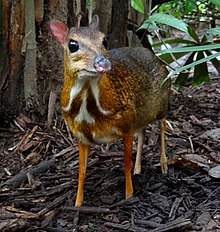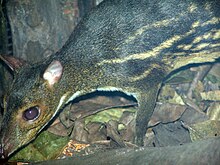Chevrotain
| Chevrotain Temporal range:
| |
|---|---|

| |
| Tragulus kanchil | |
| Scientific classification | |
| Domain: | Eukaryota |
| Kingdom: | Animalia |
| Phylum: | Chordata |
| Class: | Mammalia |
| Order: | Artiodactyla |
| Suborder: | Ruminantia |
| Infraorder: | Tragulina |
| Family: | Tragulidae H. Milne-Edwards, 1864 |
| Type genus | |
| Tragulus Brisson, 1762
| |
| Genera | |
Chevrotains, or mouse-deer, are diminutive,
In November 2019, conservation scientists announced that they had photographed
Etymology
The word "chevrotain" comes from the Middle French word chevrot (kid or fawn), derived from chèvre (goat).[10]
The single African species is consistently known as "chevrotain".[1][4][11] The names "chevrotain" and "mouse-deer" have been used interchangeably among the Asian species,[4][12][13][14] though recent authorities typically have preferred chevrotain for the species in the genus Moschiola and mouse-deer for the species in the genus Tragulus.[1] Consequently, all species with pale-spotted or -striped upper parts are known as "chevrotain" and without are known as "mouse-deer".
The Telugu name for the Indian spotted chevrotain is jarini pandi, which literally means "a deer and a pig".[citation needed] In Kannada, it is called barka (ಬರ್ಕ), in Malayalam, it is called കൂരമാൻ kūramān, and the Konkani name for it is barinka. The Tamil term is சருகு மான் sarukumāṉ "leaf-pile deer". The Sinhala name meeminna roughly translates to "mouse-like deer". This was used in the scientific name of the Sri Lankan spotted chevrotain, M. meminna.
Biology
The family was widespread and successful from the
. They give birth to only a single young.In other respects, however, they have primitive features, closer to nonruminants such as pigs. All species in the family lack antlers and horns, but both sexes have elongated

They are solitary or live in pairs.
Some of the species show a remarkable affinity with water, often remaining submerged for prolonged periods to evade predators or other unwelcome intrusions. This has also lent support to the idea that whales evolved from water-loving creatures that looked like small deer.[20][21]
Taxonomy
Tragulidae's placement within
Artiodactyla
|
| ||||||||||||||||||||||||||||||
Traditionally, only four


- Family Tragulidae
- Genus Hyemoschus
- Water chevrotain, Hyemoschus aquaticus
- Genus Moschiola
- Indian spotted chevrotain, Moschiola indica
- Sri Lankan spotted chevrotain, Moschiola meminna
- Yellow-striped chevrotain, Moschiola kathygre
- Genus Tragulus
- Java mouse-deer, Tragulus javanicus
- Lesser mouse-deer or kanchil, Tragulus kanchil
- Greater mouse-deer, Tragulus napu
- Philippine mouse-deer, Tragulus nigricans
- Vietnam mouse-deer, Tragulus versicolor
- Williamson's mouse-deer, Tragulus williamsoni
- Genus
Ancient chevrotains

The Hypertragulidae were closely related to the Tragulidae.
The six extinct chevrotain genera[3] include:
- Genus Dorcatherium
- Dorcatherium minus from Pakistan
- Dorcatherium majus from Pakistan
- Dorcatherium naui, from Central Europe[28]
- Genus Dorcabune
- Genus Afrotragulus Sánchez, Quiralte, Morales and Pickford, 2010 [29]
- Afrotragulus moruorotensis (previously "Dorcatherium" moruorotensis Pickford, 2001) (early Miocene) from Moruorot, Kenya
- Afrotragulus parvus (previously "D." parvus Withworth 1958) (early Miocene) from Rusinga Island, Kenya
- Genus Siamotragulus
- Genus Yunnanotherium
- Genus Archaeotragulus[30]
- Krabi, Thailand
The extinct chevrotains might also include[31][32]
Mythology

According to the Malay Annals, King Parameswara, seeking a place to found a new city, came to a place where he saw a mouse deer kicking his hunting dog into the water. He thought this boded well, remarking, 'this place is excellent, even the mouse deer is formidable; it is best that we establish a kingdom here'. He then founded there the city of Malacca.[citation needed] In memory of this founding legend, the Coat of arms of Malacca depicts two mouse deer.
Footnotes
- ^ Changing taxonomy in the genus Tragulus make exact species identification uncertain, but either T. javanicus or T. kanchil. Note also the contradicting English and scientific names on the sign on the photo.
References
- ^ OCLC 62265494.
- ^ a b Groves, C.; Meijaard, E. (2005). "Intraspecific variation in Moschiola, the Indian chevrotain". The Raffles Bulletin of Zoology. Supplement 12: 413–421.
- ^ a b Farooq, U.; Khan, M.A.; Akhtar, M.; Khan, A.M. (2008). "Lower dentition of Dorcatherium majus (Tragulidae, Mammalia) in the Lower and Middle Siwaliks (Miocene) of Pakistan" (PDF). Tur. J. Zool. 32: 91–98. Archived from the original (PDF) on 28 September 2011.
- ^ a b c d e f g Nowak, R.M., ed. (1999). Walker's Mammals of the World (6th ed.). Baltimore, MD: Johns Hopkins University Press.
- ^ "Hyemoschus aquaticus". Ultimate Ungulate. Retrieved 12 October 2010.
- PMID 8771414.
- ^ Chappell, Bill (11 November 2019). "Silver-Backed Chevrotain, with Fangs and Hooves, Photographed In Wild for First Time". NPR. NPR.org. Retrieved 12 November 2019.
- ^ Nguyen, An (11 November 2019). "Camera-trap evidence that the silver-backed chevrotain Tragulus versicolor remains in the wild in Vietnam". Nature.com. Retrieved 12 November 2019.
- ^ "Tiny deer-like animal spotted after 25 years" (Video). CNN. 11 Nov 2019.
- ^ "Chevrotain". Merriam-Webster.com Dictionary. Retrieved 15 December 2019.
- . Retrieved 13 November 2021.
- . Retrieved 13 November 2021.
- . Retrieved 13 November 2021.
- . Retrieved 13 November 2021.
- PMC 2100259.
- PMID 18426746.
- ISBN 0-12-408355-2.
- ^ ISBN 978-0-87196-871-5.
- ISBN 978-0-8117-0496-0.
- ^ Walker, M. (7 July 2009). "Aquatic deer and ancient whales". BBC News. Retrieved 26 March 2010.
- .
- PMID 17101039.
- S2CID 206544776.
- PMID 22930817.
- PMID 22628470.
- PMID 31800571.(see e.g. Fig S10)
- .
- ^ Thenius, E. (1950). "Über die Sichtung und Bearbeitung der jungtertiären Säugetierreste aus dem Hausruck und Kobernaußerwald (O.Ö.)". Verh. Geol. B.-A. 51 (2): 56.
- S2CID 303897.
- S2CID 85647031. Archived from the original(PDF) on 22 July 2011.
- ISBN 978-0-7637-6299-5. Retrieved 4 April 2012.
- .
- ^ "Krabitherium". Paleobiology Database (Paleodb.org). Retrieved 18 January 2013.
- ^ Mennecart, B., Wazir, W.A., Sehgal, R.K., Patnaik, R., Singh, N.P., Kumar, N. and Nanda, A.C., 2021. New remains of Nalamaeryx (Tragulidae, Mammalia) from the Ladakh Himalaya and their phylogenetical and palaeoenvironmental implications. Historical Biology, pp.1-9.https://doi.org/10.1080/08912963.2021.2014479
External links
- Lydekker, Richard (1911). . Encyclopædia Britannica (11th ed.).
